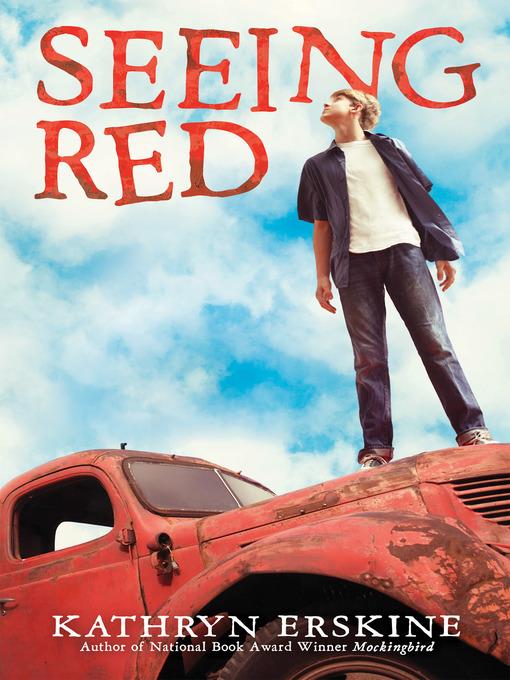
Seeing Red
فرمت کتاب
ebook
تاریخ انتشار
2013
Lexile Score
760
Reading Level
3-4
ATOS
4.6
Interest Level
4-8(MG)
نویسنده
Kathryn Erskineناشر
Scholastic Inc.شابک
9780545576451
کتاب های مرتبط
- اطلاعات
- نقد و بررسی
- دیدگاه کاربران
نقد و بررسی

September 2, 2013
In the aftermath of the civil rights movement, bigotry still permeates 1972 Stony Gap, Va., the hometown of 12-year-old Frederick “Red” Porter. Red’s father was a fair man up until the day he died, and now it’s Red’s duty to carry on his legacy. There are many wrongs Red would like to make right, like the way a neighbor, Mr. Dunlop, abuses his children. Red would also like to help an elderly African-American neighbor, Miss Georgia, whose family was cheated out of land a century ago. When Red’s mother decides they should move to Ohio, Red fears he won’t have time to correct these injustices the way his father would have wanted. Although the narrative makes heavy use of early 1970s pop culture references (especially TV shows) to build its setting, National Book Award winner Erskine (Mockingbird) offers powerful images of discrimination practiced in the South. She frankly explores the difficulty in fighting a corrupt system, but also stresses the difference one individual—even a child—can make, providing hope that justice can prevail. Ages 10–14. Agent: Linda Pratt, Wernick & Pratt.

September 1, 2013
Big changes are coming to small-town Virginia in 1972. Inheriting not just his great-great-grandfather's name, but his hair color too, 12-year-old Frederick Stewart Porter, aka Red, is grieving his father's recent death. His mother wants to sell the family auto shop and generations-old Porter land to move closer to her relatives in Ohio. Red's plan to thwart the sale becomes waylaid, however, by prejudice and family secrets. In his reflective, first-person narration tinged by references to pop culture of the time, he unknowingly joins a Klan-like group, which alienates him from his black, once-best friend, Thomas. As Red connects with Thomas' great-grandmother Miss Georgia, he vows to find the land that once held a historic African-American church. His search inadvertently uncovers a mysterious map from the past, his family's involvement in the church's demise and even his namesake's role in a murder. It also raises Red's awareness of racial inequality and the meanings of legacy and family. There's a lot going on, much of it clearly written to convey lessons. Add a teacher who encourages questioning authority, a bitter, generations-long dispute with violent neighbors, and a budding romance, and readers have a borderline didactic novel that raises too many issues with resolutions that are too quick. Still, there's no question the author's heart is in the right place. Erskine redeems many faults with a clear passion for racial justice and hope for change. (author's note) (Historical fiction. 10-14)
COPYRIGHT(2013) Kirkus Reviews, ALL RIGHTS RESERVED.

October 1, 2013
Gr 5-7-In 1972, Red Porter, 12, is dealing with the recent death of his father. His mother wants to move the family from Stony Gap, Virginia, to Ohio-which would mean that Red and his brother, J, would have to leave everyone and everything they know, including friends, the family convenience and car-repair shops, and their home that is full of memories of their father. Red is also dealing with an estrangement from his African American friend, Thomas, who severs ties with him after someone tries to burn a cross on his grandparents' yard. Red tries many ways to stay in Virginia, from vandalism to getting rid of "For Sale" signs to skipping school to work in the shop and store. He's desperate enough to seek help from his neighbor Darrell's gang, but they won't aid him unless he's initiated into the group. They convince him to burn a cross and even try to get him to beat up Thomas, who they tie up and nearly lynch. Erskine tackles many issues in this novel: death and grieving, racism and race relations, women's rights, physical abuse, and religious and educational bias. By learning through his mistakes and the advice and actions of those around him, Red evolves from an angry, grieving boy to a well-adjusted, helpful big brother who can handle a shameful family legacy.-Adrienne L. Strock, Chicago Public Library
Copyright 2013 School Library Journal, LLC Used with permission.

Starred review from September 15, 2013
Grades 5-8 *Starred Review* The year is 1972 and things are changing in tiny Stony Gap, Virginia. There's a For Sale sign in front of 12-year-old Red Porter's house; his daddy has died, and now his mama must sell both the house and their combination garage ( Porter's: We Fix It Right ) and convenience store ( What-U-Want ). Worse, she then plans to move the family to Ohio. Red is determined to stop her, but what can one 12-year-old do? When he turns to a local gang for help, he unwittingly finds himself complicit in a case of racial bigotry that leaves his friend Thomas injured and Red riddled with guilt. Meanwhile, school has started, and he has a new teacher whose passion is history. History's boring and stupid, Red protestsbut it's history that may offer him and his family a way to remain in Stony Gap. In the process of attempting to right a century-old wrong, Red learns the salutary lesson that he can make his own history. Erskine has written a powerful indictment of injustice in all forms and an equally powerful and dramatic demonstration that young people, by taking individual action, can actually change history. This is an important book that deserves the widest possible readership.(Reprinted with permission of Booklist, copyright 2013, American Library Association.)

























دیدگاه کاربران